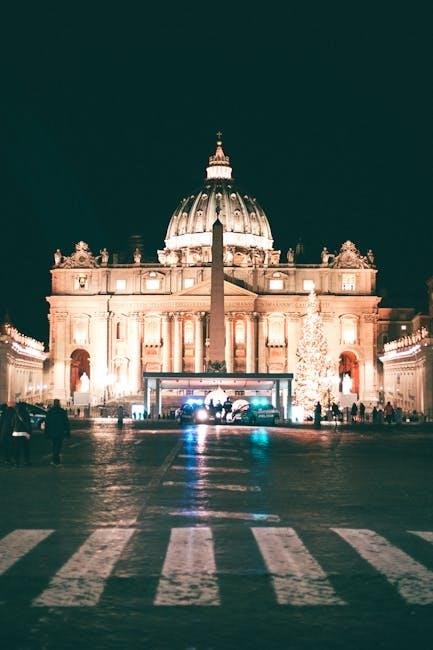“Twas the Night Before Christmas”, written by Clement Clarke Moore in 1822, is a beloved poem traditionally read on Christmas Eve in many American families.
1.1 Historical Background of the Poem
“Twas the Night Before Christmas,” also known as A Visit from St. Nicholas, was written by Clement Clarke Moore in 1822 as a Christmas gift for his children. Initially shared privately, the poem gained popularity after its publication in the Troy, New York, Sentinel in 1823. It became a cornerstone of American holiday traditions, shaping the modern image of Santa Claus and Christmas rituals. The poem’s enduring appeal lies in its vivid imagery and festive spirit, making it a timeless holiday classic. Its availability in PDF formats ensures its continued accessibility and enjoyment for new generations.

1.2 The Author: Clement Clarke Moore
Clement Clarke Moore, born in 1779, was a scholar, poet, and professor at the General Theological Seminary in New York. Best known for Twas the Night Before Christmas, Moore crafted this poem as a gift for his children in 1822. His work not only redefined Santa Claus but also popularized Christmas Eve traditions. Moore’s legacy extends beyond literature; he was a dedicated educator and philanthropist; His poem, widely available in PDF formats, remains a cherished holiday tradition, ensuring his enduring influence on Christmas celebrations and cultural heritage.
1.3 The Poem’s Popularity and Cultural Impact
Twas the Night Before Christmas has become a cornerstone of holiday tradition, widely read and cherished across generations. Its vivid imagery and rhythmic verse have captivated readers, making it a staple of Christmas Eve rituals. The poem’s influence extends beyond literature, shaping cultural perceptions of Santa Claus and holiday customs. Available in various formats, including downloadable PDFs, it remains easily accessible, ensuring its enduring popularity. Its impact on media, literature, and societal traditions underscores its significance, solidifying its place as a timeless holiday classic.


The Structure of the Poem
The poem follows a consistent rhyme and meter, with 56 lines divided into quatrains. Its anapestic tetrameter rhythm creates a lively, musical quality, enhancing its storytelling charm.
2.1 Stanzas and Rhyme Scheme
The poem is divided into eight stanzas, each following a consistent AABB rhyme scheme. This structure creates a rhythmic and harmonious flow, making it engaging and easy to recite. The use of quatrains (four-line stanzas) allows for a balanced presentation of ideas, while the rhyme enhances the musicality of the verse. The poem’s rhyme scheme contributes to its timeless appeal, as it creates a sense of predictability and joy, particularly when read aloud during holiday gatherings.
2.2 Meter and Rhythm
The poem follows a consistent anapestic tetrameter, creating a lively, rhythmic flow. Each line typically consists of four rhythmic units, with two short syllables followed by a long one. This meter contributes to the poem’s musical quality, making it enjoyable to read aloud. The steady rhythm builds anticipation and adds to the magical atmosphere, enhancing the storytelling experience. The use of rhythm and meter plays a significant role in the poem’s enduring popularity, as it captivates readers and listeners alike during holiday celebrations.
2.3 Key Imagery and Symbolism
The poem is rich in vivid imagery and symbolism, creating a magical Christmas atmosphere. The “stockings hung by the chimney with care” symbolize anticipation and hope, while “visions of sugar-plums” evoke childhood wonder. The imagery of a quiet house, “not a creature was stirring,” contrasts with the lively arrival of St. Nicholas, emphasizing the surprise and enchantment of his visit. The chimney, stockings, and reindeer are enduring symbols of Christmas tradition, while Santa Claus himself represents generosity and joy. These elements weave together to create a timeless and universally appealing holiday narrative.

Themes and Messages in the Poem
The poem explores themes of Christmas spirit, family, and the magic of Santa Claus, emphasizing joy, generosity, and the wonder of childhood, resonating universally across generations.
3.1 The Spirit of Christmas and Giving
The poem captures the essence of Christmas through its depiction of a serene household anticipating Santa’s arrival, emphasizing the spirit of giving and joy. The imagery of stockings hung by the chimney and children dreaming of sugarplums reflects the anticipation and generosity that define the season. Moore’s portrayal of Santa as a jolly, gift-giving figure has become iconic, symbolizing the heart of Christmas: selflessness, love, and the magic of giving. This theme has resonated with readers for generations, making the poem a timeless holiday classic.
3.2 Family and Tradition
The poem centers on a family’s Christmas Eve rituals, highlighting the warmth of togetherness and tradition. It describes a household preparing for Santa’s arrival, with stockings hung by the chimney and children nestled in beds. The poem, originally a gift for Moore’s children, has become a cherished tradition for many families. Its depiction of anticipation and joy emphasizes the importance of shared holiday customs, fostering a sense of unity and continuity across generations. The timeless narrative reinforces the value of family bonds and the enduring spirit of Christmas traditions.

3.3 The Magic of Santa Claus
The poem vividly portrays Santa Claus as a jolly, gift-bringing figure with a round belly, twinkling eyes, and a warm demeanor. It captures the enchantment of Santa’s arrival, describing his sleigh and reindeer as they descend silently. The imagery of Santa moving swiftly, leaving gifts, and disappearing as mysteriously as he came, underscores the magical essence of his character. This depiction has profoundly shaped the modern image of Santa Claus, embodying the spirit of generosity and joy. The poem’s portrayal of Santa’s visit has become a cornerstone of Christmas folklore, inspiring belief and wonder across generations.

The Poem’s Influence on Christmas Traditions
The poem has significantly shaped Christmas traditions, popularizing the image of Santa Claus, the idea of stockings, and the magical rituals of Christmas Eve.
4.1 Redefining Santa Claus
The poem transformed Santa Claus from a religious figure into a jolly, gift-giving character. Moore’s description of Santa as a cheerful, round man in a sleigh, pulled by reindeer, became iconic.
This image, further popularized by illustrations, reshaped holiday traditions and influenced modern depictions of Santa in media and culture, solidifying his role as a symbol of generosity and joy.
4.2 Popularizing Christmas Eve Rituals
The poem introduced and popularized the idea of Christmas Eve as a time of anticipation and joy. The tradition of children hanging stockings by the chimney and awaiting St. Nicholas became widespread.
Moore’s vivid portrayal of a quiet night filled with hope and excitement inspired families to create their own rituals, such as reading the poem together before bed. These customs have endured, making Christmas Eve a cherished part of holiday celebrations worldwide.
4.3 Impact on Holiday Literature
“Twas the Night Before Christmas” has profoundly influenced holiday literature, becoming a cornerstone of Christmas-themed stories and poems. Its rhythmic verse and vivid imagery set a standard for festive storytelling, inspiring countless adaptations and interpretations. The poem’s themes of joy, generosity, and family have shaped the tone of many holiday narratives. Additionally, its widespread availability in PDF and illustrated formats has made it accessible to readers of all ages, ensuring its enduring presence in holiday literature and education. Its influence continues to inspire writers and artists, solidifying its role as a foundational holiday text.

The Poem in Modern Media
The poem is widely available in PDF and illustrated formats, making it accessible to modern readers. It has also been adapted into films, audiobooks, and digital versions.
5.1 Illustrated Versions
Illustrated versions of “Twas the Night Before Christmas” bring the poem to life with vibrant visuals. Artists like Jessie Willcox Smith have created iconic imagery, enhancing the story’s charm. These editions are popular for reading aloud during holidays, making the tale engaging for children and adults alike. The illustrations often depict scenes of Santa, reindeer, and festive settings, capturing the poem’s magical essence. Many PDF versions include these illustrations, allowing readers to enjoy them digitally. The combination of text and art has made the poem a staple in holiday literature and decorations.
5.2 Film and Audio Adaptations
Film and audio adaptations of “Twas the Night Before Christmas” have further popularized the poem. Animated specials and voice recordings bring the story to life, engaging audiences of all ages. Notable adaptations include animated films featuring Santa Claus and his reindeer, while audio versions, often narrated by celebrated voices, enhance the festive experience. These adaptations have made the poem more accessible, allowing it to reach a wider audience beyond traditional readings. Digital platforms now offer these adaptations alongside PDF downloads, ensuring the poem remains a cherished part of holiday traditions.
5.3 Digital Versions and PDF Downloads
Digital versions and PDF downloads of “Twas the Night Before Christmas” have made the poem more accessible than ever. Illustrated PDFs, often designed with vibrant visuals, allow readers to enjoy the story in a visually engaging format. Many free downloadable versions are available online, perfect for sharing with family or incorporating into holiday curricula. These digital adaptations preserve the poem’s charm while introducing it to a new generation. PDFs are particularly popular for their ease of use, enabling readers to print or view the poem on various devices, ensuring its timeless appeal endures in the digital age.

Educational Uses of the Poem
“Twas the Night Before Christmas” is widely used in schools for teaching literature and holiday-themed lessons. Its brevity and engaging rhythm make it ideal for reading exercises and family recitals, ensuring its enduring educational relevance.
6.1 Teaching Literature in Schools
The poem is a popular choice in schools for teaching literature, particularly during the holiday season. Its rhythmic verse and engaging narrative make it accessible to students of all ages. Teachers often use the poem to introduce students to classic holiday literature, emphasizing its cultural and historical significance. The poem’s structure, with its consistent rhyme and meter, serves as an excellent tool for teaching poetic devices and language arts skills. Additionally, its themes of family and tradition align with holiday curriculum, making it a valuable resource for educators seeking to integrate festive themes into their lesson plans while fostering a love for reading.
6.2 Language and Creative Writing Exercises
The poem is widely used in schools for language and creative writing exercises, offering students a rich text to analyze and emulate. Its rhythmic verse and rhyme scheme provide a foundation for teaching poetic devices, while its vivid imagery encourages creative writing tasks. Students often craft their own holiday-themed stories inspired by the poem’s themes of anticipation and joy. Additionally, the poem’s accessible language makes it an ideal model for teaching descriptive writing and narrative structure. Educators also use the poem to inspire students to write from different perspectives, fostering creativity and linguistic skills in a festive context.
6.3 Holiday-Themed Curriculum Integration
Teachers often integrate the poem into holiday-themed curricula to connect literacy with cultural traditions. It is used to explore themes like family, giving, and cultural traditions, fostering a deeper understanding of festive values. The poem’s historical context and imagery offer opportunities to discuss 19th-century traditions, allowing students to compare past and present celebrations. Additionally, the poem’s availability in PDF formats makes it easy to distribute and use in classrooms, enabling interactive reading sessions and group discussions. This integration enriches students’ learning experiences, making the holiday season a meaningful part of their academic journey while preserving cultural heritage for future generations.

The Poem’s Legacy and Adaptations
“Twas the Night Before Christmas” has been translated into multiple languages and adapted into parodies, modern interpretations, and cultural variations, ensuring its enduring relevance across diverse audiences globally.
7.1 Translations into Other Languages
The poem has been translated into numerous languages, spreading its charm worldwide. Available as free PDFs, these translations allow diverse cultures to enjoy the Christmas spirit. Digital versions, including PDF downloads, have made it accessible globally, preserving its legacy. Illustrations in these PDFs enhance the holiday atmosphere, making it a popular choice for families. The poem’s universal themes transcend language barriers, fostering a global connection to Christmas traditions. Its widespread translations and digital availability ensure its continued relevance in the modern era, reaching readers of all linguistic backgrounds.
7.2 Parodies and Modern Interpretations
The poem has inspired countless parodies and modern reinterpretations, reflecting its enduring cultural relevance. These creative adaptations often humorously or critically reinterpret the original narrative, adapting it to contemporary contexts. Political satires, humorous twists, and even genre mashups have emerged, showcasing the poem’s versatility. Modern media, including PDF downloads and digital versions, facilitate the sharing of these reinterpretations, allowing new audiences to engage with the classic tale in fresh ways. Such adaptations highlight the poem’s ability to evolve while retaining its timeless charm and universal appeal, ensuring its continued resonance in modern society.
7.3 Cultural Variations and Inspirations
The poem has inspired cultural variations worldwide, with translations into multiple languages and adaptations reflecting diverse traditions. Illustrated versions, such as those by Jessie Willcox Smith, have brought unique visual interpretations, while holiday games like the “Right Left Christmas Game” incorporate the poem’s themes. These variations highlight the poem’s universal appeal, allowing it to resonate across cultures. PDF downloads and digital versions further facilitate its global reach, ensuring its message of joy and giving continues to inspire new generations and cultural practices, making it a timeless holiday classic.
The poem remains a timeless holiday classic, with its PDF versions and traditions continuing to inspire joy and unity across generations and cultures worldwide.
8.1 The Timeless Appeal of the Poem
The poem’s enduring charm lies in its vivid imagery, rhythmic flow, and universal themes of hope and joy, resonating across generations and cultures. Its depiction of Santa Claus and Christmas traditions has shaped holiday celebrations globally. The poem’s ability to evoke nostalgia and wonder ensures its relevance in modern times, making it a cherished part of holiday literature. Its adaptability into various formats, including PDFs, has further cemented its place in cultural heritage, ensuring its timeless appeal continues to captivate readers of all ages.
8.2 Its Role in Holiday Celebrations
The poem has become a cornerstone of Christmas traditions, often read aloud on Christmas Eve to evoke festive spirit. Its vivid imagery of Santa Claus, reindeer, and stocking-hung chimneys has shaped holiday rituals worldwide. Families cherish the poem as a way to bond and pass down cultural heritage. Its themes of joy, generosity, and anticipation resonate deeply, making it a timeless companion to holiday celebrations. The poem’s widespread availability in PDF and illustrated formats ensures its continued presence in homes, inspiring love and excitement for the season across generations.
8.3 Continued Relevance in the Digital Age
The poem remains highly relevant in the digital age, with its timeless themes and festive spirit continuing to captivate audiences. Its availability in PDF and digital formats ensures easy access for modern readers. Families can download and print illustrated versions, making it a convenient addition to holiday traditions. The poem’s adaptability to new technologies has allowed it to thrive, with digital versions preserving its charm for future generations. Its enduring appeal lies in its universal message of joy and generosity, making it a cherished part of holiday celebrations in both physical and digital forms.

